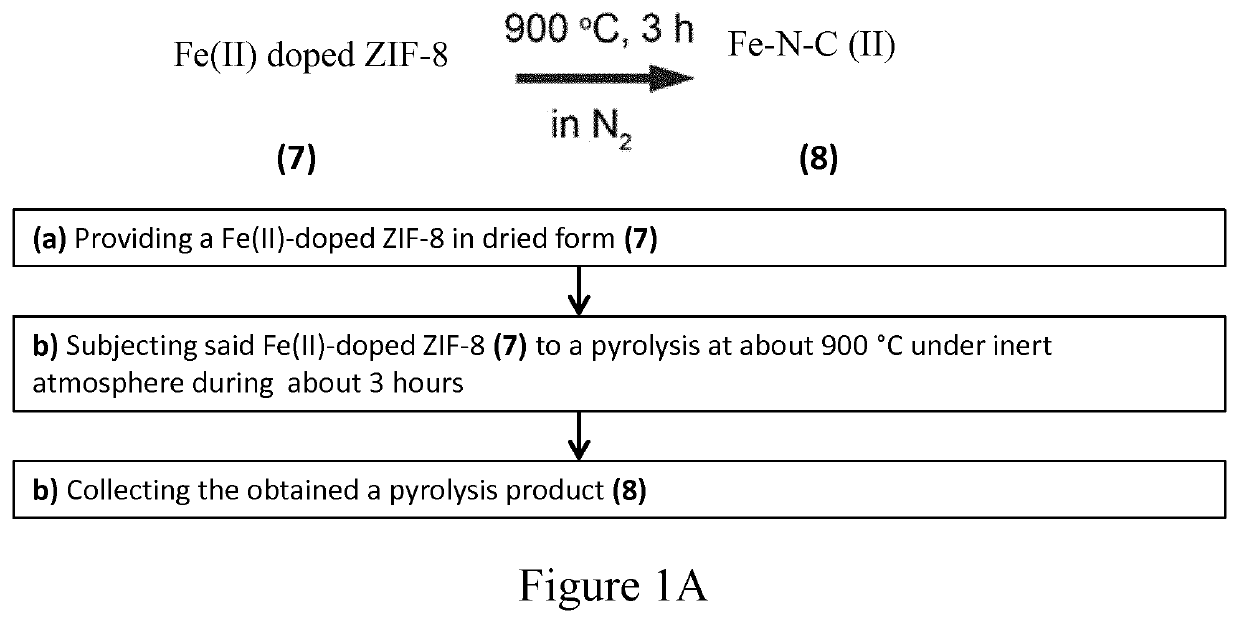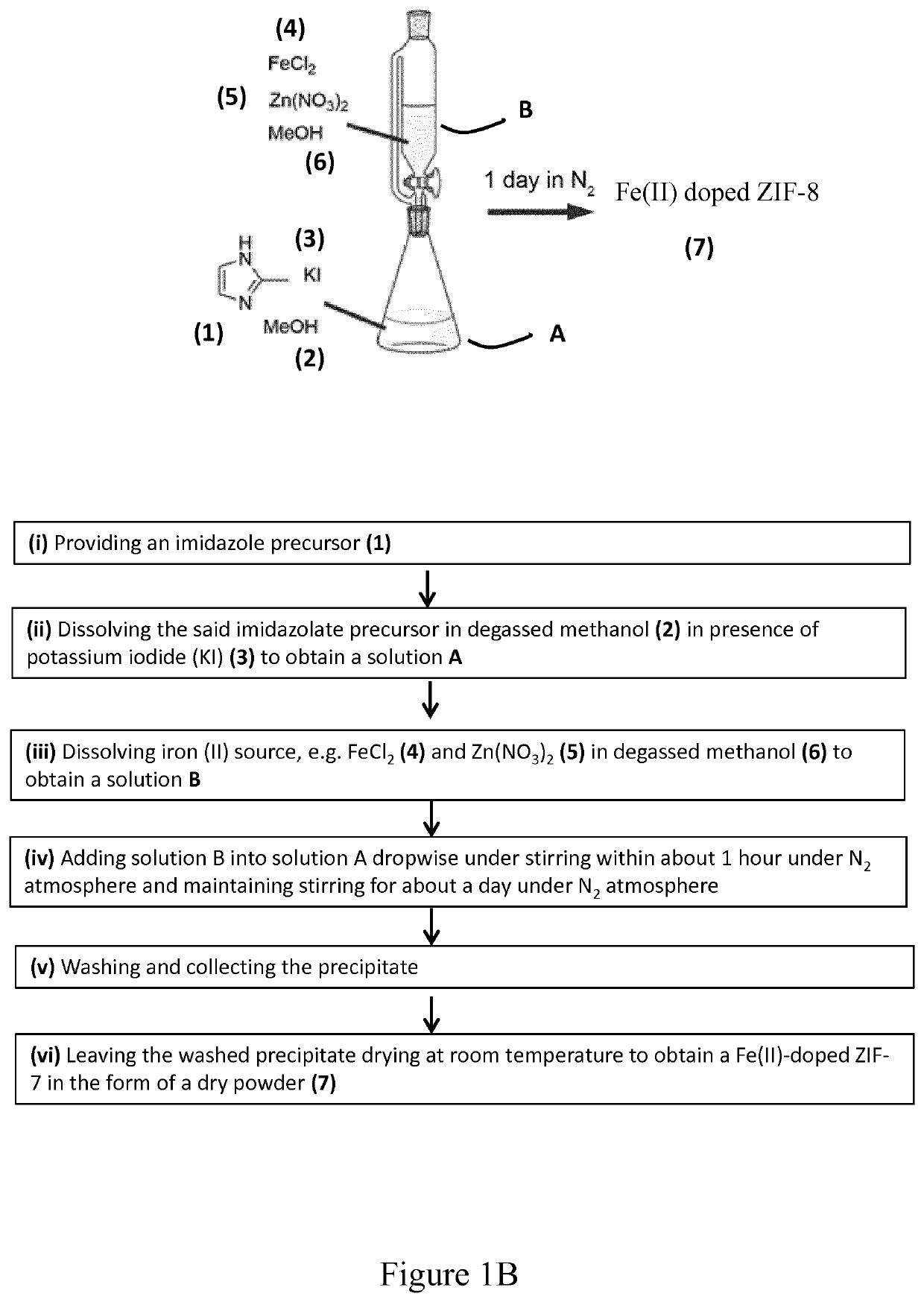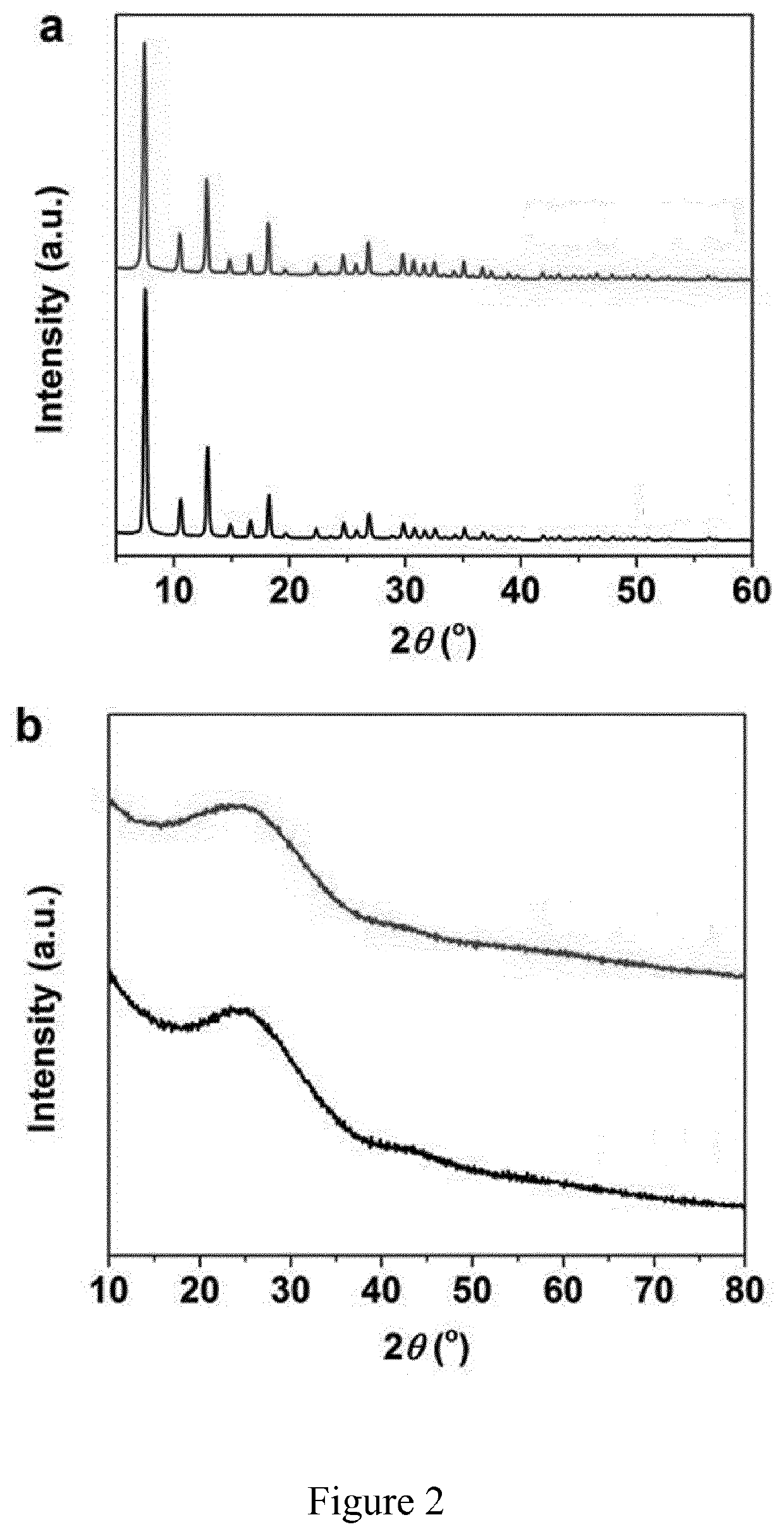Fe-N-C CATALYST, METHOD OF PREPARATION AND USES THEREOF
a catalyst and catalyst technology, applied in the field of electrochemical reduction of carbon dioxide, can solve the problems of low selectivity for the desired product, low conversion rate, and high cost of this catalyst, and achieve the effects of reducing the overall production cost, limiting the amount of catalytic material to use, and stable over time of us
- Summary
- Abstract
- Description
- Claims
- Application Information
AI Technical Summary
Benefits of technology
Problems solved by technology
Method used
Image
Examples
example 1
on of a Fe(II) Doped Zn-ZIF Precursor
[0102]A method of the invention for the preparation of a Fe(II)-doped Zn-zeolitic imidazole frameworks (ZIFs) according to the invention is illustrated on FIG. 1B for a Fe(II) doped zinc imidazolate (ZIF-8). In order to prevent the oxidation of Fe(II) species during the reaction, the reaction medium, i.e. methanol (MeOH) or ethanol was degassed by bubbling N2 before usage and the synthesis of Fe(II) doped Zn-ZIF-8 material was conducted in a glove box as follows:
[0103]Providing an Imidazolate Precursor Preparing a Solution A:
[0104]First, 1.314 g of 2-methylimidazole (2-mIm) is provided as an imidazolate precursor and 0.076 g of potassium iodide (KI) were dissolved in 15 mL of MeOH to form solution A.
[0105]Providing Iron (II) Chloride Preparing a Solution B:
[0106]0.080 g of FeCl2.4H2O or 0.063 g of FeCl2 as a Fe (II) precursor and 1.190 g of Zn(NO3)2.6H2O were dissolved in 25 mL of MeOH to form solution B.
[0107]Adding Solution B into Solution a Un...
example 2
on of a Catalytic Material of the Invention from a Fe(II) Doped Zn-ZIF
[0111]A method of the invention for the preparation of a catalyst containing Fe single atoms on N doped carbon matrix obtained from a Fe(II) doped Zn-ZIF according to the invention is illustrated on FIG. 1A using the Fe(II) doped zinc imidazolate (ZIF-8) obtained in Example 1 as a precursor for pyrolysis. The Fe(II) doped zinc imidazolate (ZIF-8) precursor obtained in Exampled 1 was immersed in hexane during the transfer from glove box to the tube furnace to prevent possible oxidation caused by exposing to air. The pyrolysis is then carried out in the tube furnace with N2 with a flow rate of 100 mL·min−1 at 900° C. for 3 hours with a ramping rate of 5° C.·min−1. The catalytic material resulting from the pyrolysis is obtained as a black powder. The obtained yield based on Fe is about 90%.
example 3
ization of the Fe(II) Doped Zinc Imidazolate (ZIF-8) Precursor and its Pyrolyzed Product
[0112]The X-ray diffraction (XRD) patterns of the un-doped ZIF-8 prepared with the same method in Example 1 except that FeCl2 or FeCl2.4H2O was not added and of the Fe(II) doped zinc imidazolate (ZIF-8) precursor of the invention were compared as reported on FIG. 2a. The XRD patterns of the materials obtained after pyrolysis of un-doped ZIF-8 and Fe(II) doped ZIF-8 were compared as reported on FIG. 2b. To prepare the sample for XRD characterization, the solid form of the material was first dispersed in small amount of ethanol, dropped on a glass slide and dried naturally. The XRD measurements were conducted on an X′Pert™ Philips diffractometer with monochromatic Cu Kα radiation and a fast Si-PIN multi-strip detector.
[0113]As shown on FIG. 2a, un-doped ZIF-8 (top) and Fe(II) doped ZIF-8 (bottom) have similar X-ray diffraction (XRD) patterns, indicating that the crystal structure of ZIF-8 did not c...
PUM
| Property | Measurement | Unit |
|---|---|---|
| temperature | aaaaa | aaaaa |
| temperature | aaaaa | aaaaa |
| temperature | aaaaa | aaaaa |
Abstract
Description
Claims
Application Information
 Login to View More
Login to View More - R&D
- Intellectual Property
- Life Sciences
- Materials
- Tech Scout
- Unparalleled Data Quality
- Higher Quality Content
- 60% Fewer Hallucinations
Browse by: Latest US Patents, China's latest patents, Technical Efficacy Thesaurus, Application Domain, Technology Topic, Popular Technical Reports.
© 2025 PatSnap. All rights reserved.Legal|Privacy policy|Modern Slavery Act Transparency Statement|Sitemap|About US| Contact US: help@patsnap.com



